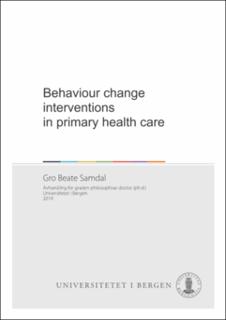| dc.contributor.author | Samdal, Gro Beate | en_US |
| dc.date.accessioned | 2020-09-21T07:28:53Z | |
| dc.date.available | 2020-09-21T07:28:53Z | |
| dc.date.issued | 2019-03-12 | |
| dc.identifier.isbn | 978-82-308-3539-5 | en_US |
| dc.identifier.uri | https://hdl.handle.net/1956/24092 | |
| dc.description.abstract | As part of a public health promotion strategy, and in order to prevent noncommunicable diseases (NCDs), the Directorate of Health recommends that Norwegian municipalities establish Healthy Life Centres (HLCs). This thesis builds on two studies that aim to: 1) find evidence of effect from interventions similar to the HLCs’ interventions and explore if intervention characteristics could explain differences in effect between studies, and 2) evaluate the effects of HLC interventions. In Study 1, we performed a systematic review of 48 randomised controlled trials (RCTs) of diet and physical activity interventions. We performed meta-analyses of 50 short-term (ES 0.37) and 32 long-term results (ES 0.24). Meta-regression analyses revealed that using several behaviour change techniques (BCTs), and especially the BCTs goal setting of behaviour or self-monitoring of behaviour, were associated with positive results at both short and long-term. Several other BCTs were associated with a long-term effect. There was evidence that a patient-centred and autonomous supportive approach in counselling seemed important to maintain change over time. In sum, interventions similar to the HLCs’ interventions were modestly effective in changing behaviour in the short-term, with reduced effect long-term. These results may support the design and implementation of HLC interventions and help to identify the competence needed in counselling for maintenance of change. In Study 2, we evaluated the effect of HLCs’ interventions on physical activity, selfreported health and quality of life, quality of diet and diet behaviour, use of tobacco, sleep pattern, and body image. We designed a six-month randomised controlled trial (RCT) with a longitudinal follow-up 24 months after baseline. We recruited 118 participants (35% of those invited). The participants were predominantly middleaged, obese, physically active, females motivated for change. Reasons for attendance were: being overweight, wanting to increase physical activity, to have a healthier diet, and to address musculoskeletal and mental health challenges. At the start of the trial, 70% of participants did 150 minutes of moderate to vigorous physical activity (MVPA) per week. The HLC interventions had no effect on the amount of time spent in MVPA or in sedentary behaviour after six months. However, those less physically active in the intervention group significantly increased their activity levels, as compared with the less active in the control group. The drop-out rate was 30%, and participants with mental health issues, musculoskeletal challenges or chronic somatic disease were more likely to leave the study. The HLCs recruited participants with lower education and income as intended. It is unlikely that interventions that encompass people who are already physically active will improve population health or mitigate social differences in health. The differences we identified in physical activity between educational groups seemed to widen during follow-up, and the interventions did not mitigate these differences. | en_US |
| dc.language.iso | eng | eng |
| dc.publisher | The University of Bergen | eng |
| dc.relation.haspart | Paper I: Samdal GB, Eide GE, Barth T, Williams G, Meland E. Effective behaviour change techniques for physical activity and healthy eating in overweight and obese adults: systematic review and meta-regression analyses. International Journal of Behavioral Nutrition and Physical Activity. 2017;14(1):42. The article is available at: <a href="http://hdl.handle.net/1956/18409" target="blank">http://hdl.handle.net/1956/18409</a> | en_US |
| dc.relation.haspart | Paper II: Abildsnes E, Meland E, Mildestvedt T, Stea TH, Berntsen S, Samdal GB. The Norwegian Healthy Life Study: protocol for a pragmatic RCT with longitudinal follow-up on physical activity and diet for adults. BMC Public Health. 2017;17(1):18. The article is available at: <a href="http://hdl.handle.net/1956/16298" target="blank">http://hdl.handle.net/1956/16298</a> | en_US |
| dc.relation.haspart | Paper III: Samdal GB, Meland E, Eide GE, Berntsen S, Abildsnes E, Stea TH, et al. Participants at Norwegian Healthy Life Centres: Who are they, why do they attend and how are they motivated? A cross-sectional study. Scandinavian Journal of Public Health. 2018;46(7):774-781. The article is not available in BORA due to publisher restrictions. The published version is available at: <a href=" https://doi.org/10.1177%2F1403494818756081" target="blank"> https://doi.org/10.1177%2F1403494818756081</a> | en_US |
| dc.relation.haspart | Paper IV: Samdal GB, Meland E, Eide GE, Berntsen S, Abildsnes E, Stea TH, et al. The Norwegian Healthy Life Centre Study: A pragmatic RCT of physical activity in primary care. Scandinavian Journal of Public Health. 2018;47(1):18-27. The article is not available in BORA due to publisher restrictions. The published version is available at: <a href="https://doi.org/10.1177%2F1403494818785260" target="blank"> https://doi.org/10.1177%2F1403494818785260</a> | en_US |
| dc.rights | In copyright | eng |
| dc.rights.uri | http://rightsstatements.org/page/InC/1.0/ | eng |
| dc.title | Behaviour change interventions in primary health care | en_US |
| dc.type | Doctoral thesis | |
| dc.rights.holder | Copyright the author. All rights reserved | |
| dc.identifier.cristin | 1684694 | |
